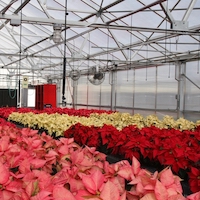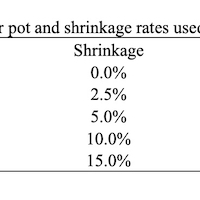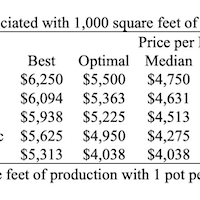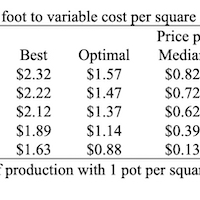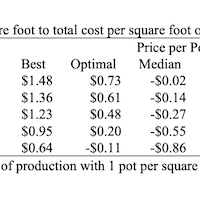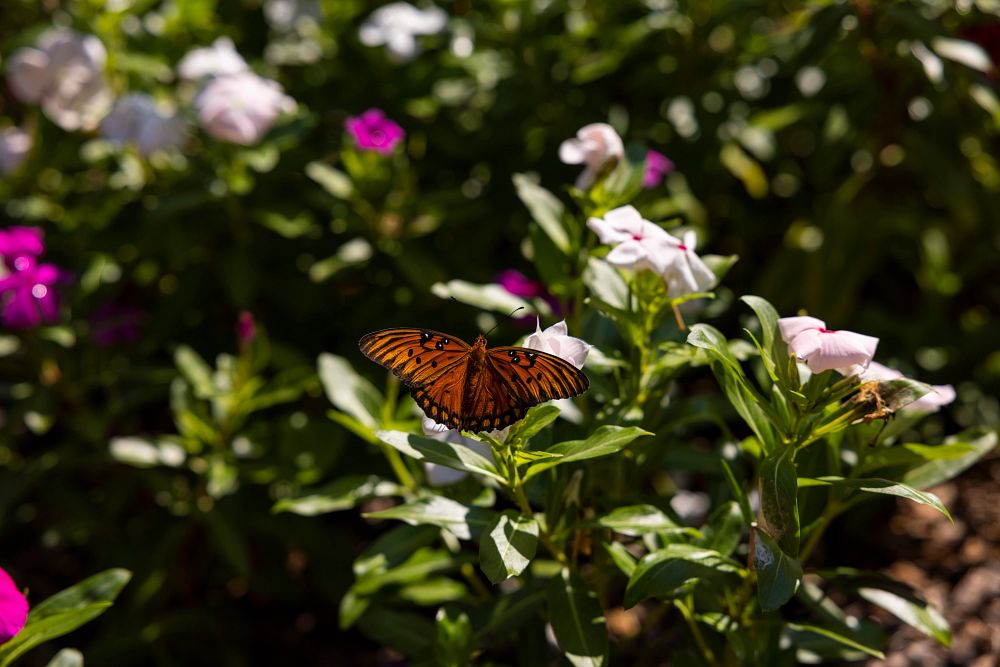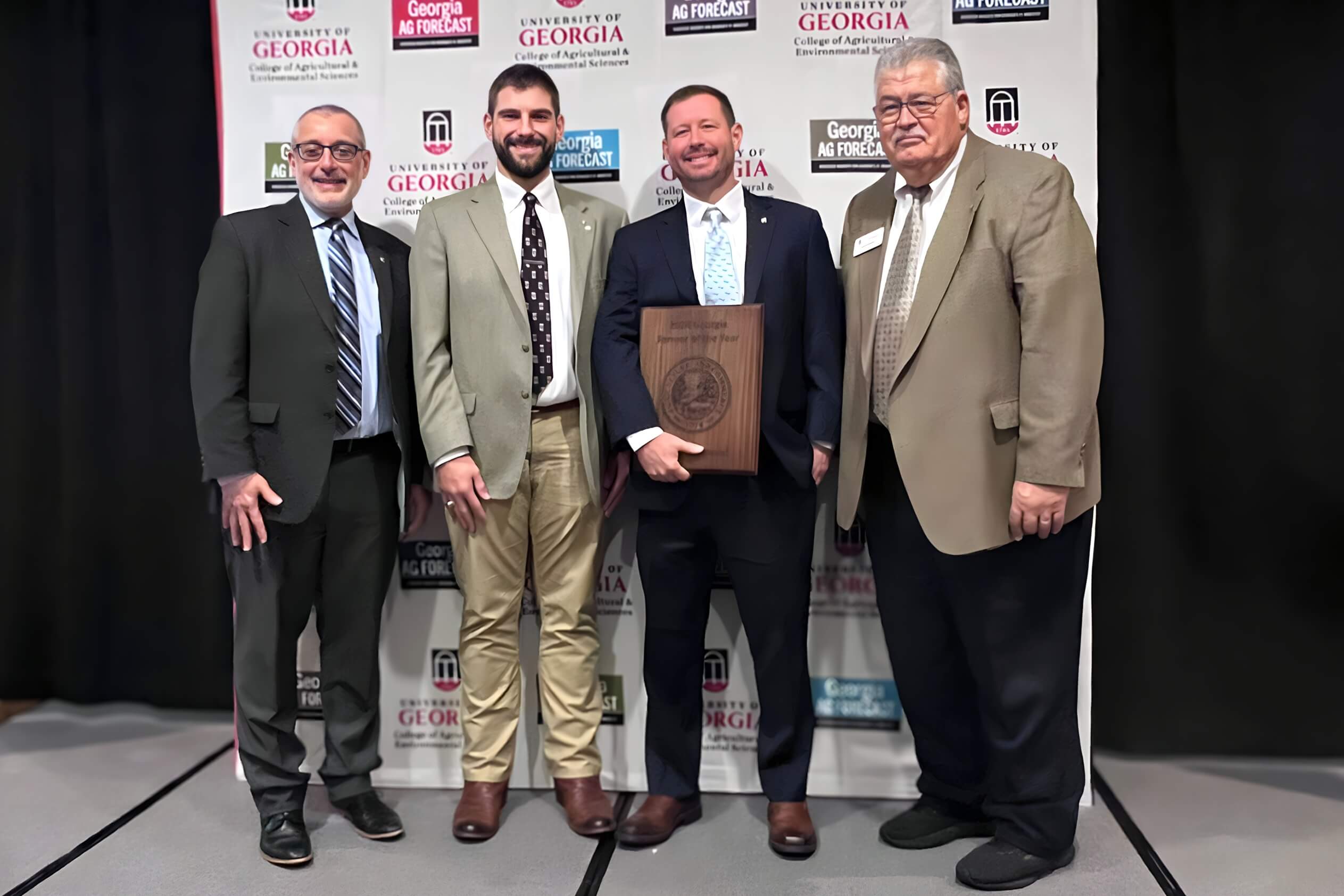The purpose of this fact sheet is to demonstrate the impact shrinkage has on profitability. Although the focus is on poinsettia production, the underlying findings can be applied across greenhouse and nursery operations.
The fundamental finding is that shrinkage can move a profitable firm into becoming unprofitable. A producer cannot eliminate all shrinkage, but small reductions in shrinkage may have a significant impact on profitability. To better understand the impact of shrinkage on profitability, a poinsettia production budget was developed similar to the budget found in “Starting a Greenhouse Business” (by Paul Thomas and William Thomas, 2009).
After updating the costs, various shrinkage rates and prices per pot (Table 1) were simulated to determine the impact on profitability. Production area was set at 1,000 square feet with one square foot of space per pot. Thereby, final yield was 1,000 pots times the sum of one minus the shrinkage rate. For instance, in the worst shrinkage case final yield was 850 pots = [1,000 * (1 - 0.15)]. Revenues were calculated as the pot yield times the price per pot, which varied based on the simulation.
Finally, revenue per pot was compared against the variable costs and total costs.
As can be seen in Table 2, revenues can be significantly impacted by both prices and shrinkage. With respect to shrinkage, a 0% shrinkage (best option) results in $738 more revenue compared to the worst shrinkage level (15% loss) when evaluated at the median price. Moving from a 10% shrinkage rate to a 5% rate generates between $175 and $313 more revenue, depending on the price level.
Comparing revenues per square foot to a variable cost per square foot (Table 3) indicates that decreasing shrinkage will not make a firm cover variable costs if prices are low. However, reducing shrinkage can have a large impact on the amount of loss/gain per pot. For instance, moving from 15% shrinkage (worst) to 10% shrinkage (pessimistic) results in a $0.26 additional revenue above variable costs. While moving from 5% (median) to 2.5% (optimal) shrinkage results in a $0.10 additional revenue above variable costs.
When evaluating overall profitability, reducing shrinkage will not solely alleviate the impact of low prices. In our simulation, shown in Table 4, the producer would lose money per square foot (or per pot) at the median price level and below. However, the losses are significantly less when decreasing the shrinkage rate. Moving from a $0.27 per square foot loss (median price, median shrinkage) to a $0.14 loss (median price, optimal shrinkage) saves $0.13 per square foot in losses for a total $130 loss per 1,000 square feet of production. Although $130 loss per 1,000 square feet is not a huge number, decreasing shrinkage can move to a more profitable firm at all price levels.
Conclusions
Many producers do not consider or take the time to measure shrinkage within their operations. However, shrinkage can be an easy way to increase profitability. As a first step, producers should identify how much shrinkage their operation experiences. After establishing a benchmark, greenhouse and nursery operations should look for ways to decrease shrinkage. Many causes of shrinkage may be apparent, such as watering or disease issues. After fixing major issues, operations can focus on fine-tuning their operations to reduce shrinkage on a smaller level. Issues may include lack of watering or overwatering which can be fixed by optimizing irrigation which thereby reduces sub-optimal plant growth and disease loss. Incorrect fertilization may result in unacceptable plant size and shape or a shorter shelf-life on a retail shelf. Further, overproducing can produce high levels of shrink if the extra volume of plants cannot be sold. Greenhouse producers need to understand the causes of shrinkage within their operation and take steps to correct issues that are found.
A number of resources exist that can help greenhouse producers identify areas to lower shrinkage within their operation:
- Roberto Lopez. 2009. Reducing Crop Shrinkage. Greenhouse Grower. https://www.greenhousegrower.com/production/plant-culture/reducing-crop-shrinkage/ http://www.greenhouse.cornell.edu/crops/factsheets/CropShrinkage.pdf
- Jamie Gibson, Bob Steinkamp, Michael Tilley, and Hugh Poole. 2011. Reduce Shrink. Greenhouse Management. https://www.greenhousemag.com/article/gm1211-limit-crop-shrink/
- Will Healy. 2012. Managing Shrinkage. Greenhouse Product News. https://gpnmag.com/article/managing-shrinkage/
- Paul Fisher, Alan Hodges, Bill Swanekamp, Kube-Pak Corp., and Charles Hall. 2014. The New Economics of Greenhouse Production. http://ellisonchair.tamu.edu/files/2013/09/Combined-costing-series.pdf
References
Thomas, P.A. and W.A. Thomas. 2009. Starting a Greenhouse Business. University of Georgia, College of Agricultural and Environmental Sciences publication, B1134.
https://athenaeum.libs.uga.edu/bitstream/handle/10724/12371/B1134.pdf?sequence=1

